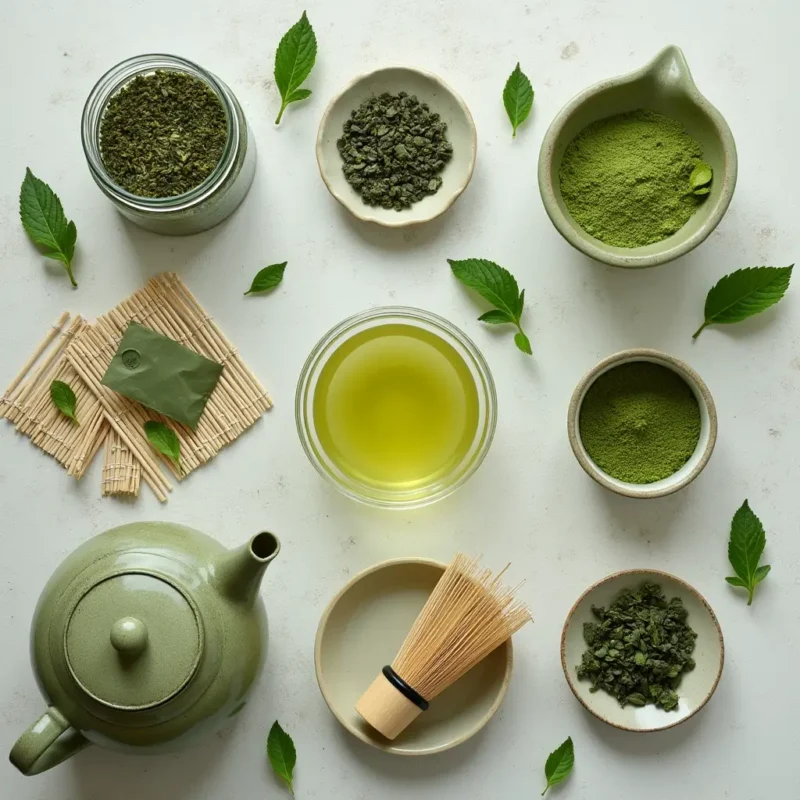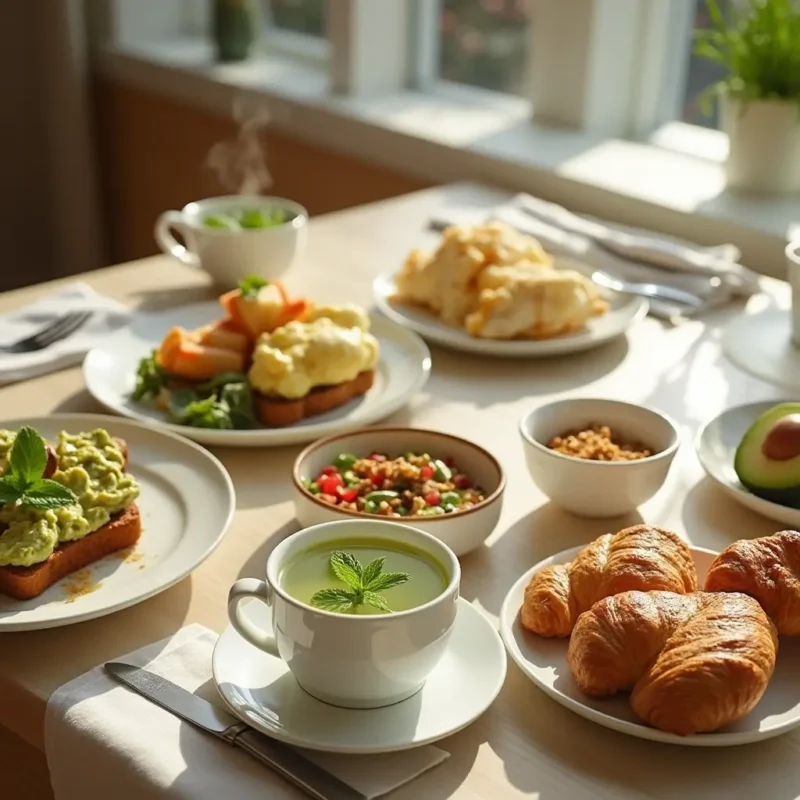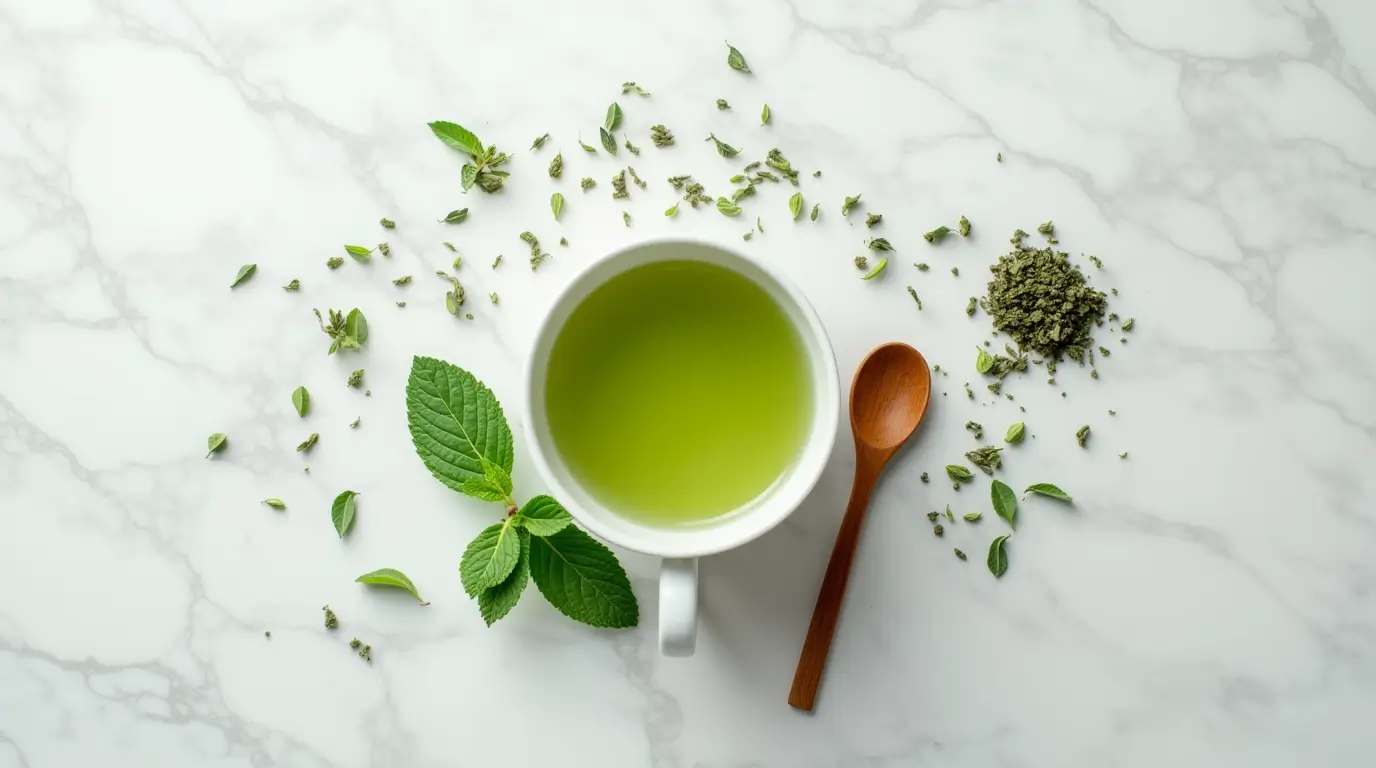Green tea recipe — there’s something timeless about the quiet ritual of brewing a cup. Imagine starting your day with a warm, earthy sip that not only awakens your senses but also fuels your health. Green tea is more than just a drink — it’s a lifestyle embraced by millions. Whether you’re trying a refreshing cold brew or a cozy matcha latte, there’s a green tea recipe perfect for every taste.
In this guide, we’ll show you how to choose the best leaves, master the ideal brewing method, and add your creative twists. Discover the science-backed benefits, avoid common mistakes, and make every cup a moment to savor. Ready to brew? Let’s begin.
What is Green Tea?
Green tea comes from the Camellia sinensis plant, the same source as black tea. However, unlike black tea, green tea is minimally processed, which helps preserve its natural antioxidants and delicate flavor. You might have heard of varieties like matcha, sencha, or gyokuro. Each type offers a unique taste profile, but they all share one thing in common: their incredible health benefits.
Green tea has been cherished for thousands of years, particularly in Asia, where it’s often enjoyed during mindfulness practices like meditation. Nowadays, it’s become a global phenomenon, thanks to its versatility and reputation as a superfood.
Why Green Tea is a Superfood
Here’s the deal: green tea is packed with antioxidants, specifically catechins like EGCG (epigallocatechin gallate). These compounds are known for their ability to fight free radicals, reduce inflammation, and even support weight loss. But wait—there’s more!
- Boosts Brain Power: Thanks to L-theanine, an amino acid found in green tea, you can enjoy improved focus without the jittery side effects of coffee.
- Supports Heart Health: Studies suggest that regular consumption of green tea may lower LDL cholesterol and improve blood vessel function.
- Aids Weight Loss: Need a little help shedding those extra pounds? A well-brewed green tea recipe could be your secret weapon.
The Importance of a Good Green Tea Recipe
Sure, you could just toss some tea leaves into hot water and call it a day—but why settle for mediocre when you can have magnificent? The way you brew green tea plays a huge role in unlocking its full potential. Over-steeping or using water that’s too hot can turn your tea bitter faster than you can say “matcha latte.” On the flip side, getting it right means enjoying a smooth, flavorful cup every time.
By the end of this guide, you’ll know exactly how to craft the best green tea recipe tailored to your taste buds. So, are you ready to elevate your tea game? Let’s move on to Part 2, where we’ll talk about choosing the perfect green tea leaves for your brew.
Part 2: How to Choose the Best Green Tea for Your Recipe

Choosing the right green tea is like picking the perfect ingredient for a recipe—it makes all the difference. After all, even the best green tea recipe can fall flat if the leaves aren’t up to par. Let’s explore how you can find the crème de la crème of green tea for your brewing adventures.
Types of Green Tea Leaves
First things first: not all green teas are created equal. You’ve got two main options—loose leaf or tea bags—and each has its pros and cons.
- Loose Leaf: If you’re after premium flavor and aroma, loose leaf green tea is the way to go. The leaves are larger and less processed, which means they retain more of their natural goodness. Plus, they give you more control over steeping time.
- Tea Bags: On the other hand, tea bags are convenient and mess-free. However, they often contain smaller, broken leaves or even tea dust, which can lead to a less refined taste. That said, some high-quality brands now offer pyramid-style bags that allow for better infusion.
So, what’s the verdict? If you’re serious about crafting an unforgettable green tea recipe, loose leaf is usually the better bet.
Where to Buy High-Quality Green Tea
Now that you know what to look for, where should you buy it? Here’s the scoop:
- Reputable Brands: Brands like Harney & Sons, The Republic of Tea, and Ito En are known for their commitment to quality.
- Specialty Stores: Check out local tea shops or online retailers that specialize in artisanal teas.
- Authenticity Matters: When buying Japanese varieties like matcha or sencha, opt for products sourced directly from regions like Uji or Shizuoka.
Green Tea Variations You Can Experiment With
Feeling adventurous? Don’t limit yourself to just one type of green tea. For instance, try matcha powder if you’re in the mood for a latte, or go for sencha if you prefer a classic hot brew. The possibilities are endless!
With the right tea in hand, you’re ready to move on to Part 3, where we’ll dive into the nitty-gritty of brewing the perfect cup.
Part 3: Step-by-Step Green Tea Recipe
Alright, tea enthusiasts, it’s time to roll up your sleeves and brew the perfect cup of green tea. Whether you’re a newbie or a seasoned sipper, this step-by-step guide will help you master the art of crafting a delicious green tea recipe.
Basic Green Tea Brewing Method
Brewing green tea isn’t rocket science, but it does require a bit of finesse. Follow these steps to ensure your tea is smooth, flavorful, and free of bitterness:
- Heat Your Water: Start by heating water to the ideal temperature—between 70-85°C (158-185°F). Why? Boiling water can scorch the delicate leaves, leaving you with a bitter brew.
- Measure the Leaves: Use about 1 teaspoon of loose leaf tea (or one tea bag) per cup of water. Adjust based on your taste preferences.
- Steep Gently: Pour the hot water over the leaves and let them steep for 2-3 minutes. Keep an eye on the clock; over-steeping is a common culprit behind bitter tea.
- Strain and Serve: Once the time’s up, strain the leaves (if using loose leaf) and enjoy your perfectly brewed cup of green tea.
Pro tip: If you want to take your green tea recipe to the next level, add a slice of lemon or a sprig of mint for a refreshing twist.
Cold Brew Green Tea Recipe
Looking for something cool and refreshing? Cold brew green tea is your answer. Here’s how to make it:
- Combine Tea and Water: Place 2 teaspoons of loose leaf green tea (or 2 tea bags) in a pitcher with 4 cups of cold, filtered water.
- Let It Steep Overnight: Cover the pitcher and refrigerate for 6-8 hours. Patience pays off here!
- Strain and Enjoy: Strain out the leaves and serve over ice. Add fresh fruit like lemon slices or berries for a burst of flavor.
This method is perfect for summer days when you need a hydrating, caffeine-light pick-me-up.
Matcha Green Tea Latte Recipe
If you’re a fan of creamy drinks, you’ll love this matcha green tea latte recipe. Here’s how to whip it up:
- Mix Matcha Paste: Sift 1 teaspoon of matcha powder into a bowl. Add 2 tablespoons of hot water and whisk until smooth.
- Heat Your Milk: Warm 1 cup of milk (dairy or plant-based) on the stove or in a frother.
- Combine and Froth: Pour the milk into the matcha paste and whisk until frothy. Sweeten with honey or agave syrup if desired.
Voilà! You’ve just made a café-worthy drink at home.
And there you have it—three fantastic ways to enjoy green tea. But wait, there’s more! In Part 4, we’ll explore how to customize your green tea recipe to suit your unique tastes.
Part 4: Customizing Your Green Tea Recipe
Let’s face it—sometimes, plain green tea can feel a little… well, plain. But here’s the good news: with a few tweaks, you can turn your green tea recipe into a personalized masterpiece. Whether you’re looking to sweeten things up or add a spicy kick, customization is where the magic happens.
Adding Natural Sweeteners
If you’ve got a sweet tooth but want to keep things healthy, natural sweeteners are your best friend. Here’s how they can enhance your brew:
- Honey: A drizzle of honey not only sweetens your tea but also adds a touch of floral flavor. Plus, it’s packed with antioxidants, making it a win-win.
- Stevia: For those watching their sugar intake, stevia is a calorie-free alternative that’s incredibly potent—a little goes a long way.
- Agave Syrup: This mild, plant-based sweetener blends seamlessly into green tea without overpowering its delicate taste.
By experimenting with these options, you can create a green tea recipe that satisfies your cravings while staying wholesome.
Enhancing Flavor with Spices
Spices are a game-changer when it comes to elevating your tea. Here’s what you can try:
- Ginger: A slice of fresh ginger adds warmth and a zesty kick, perfect for cold mornings or when you’re feeling under the weather.
- Cinnamon: Sprinkle a pinch of cinnamon into your brew for a cozy, autumnal vibe. It’s also great for balancing blood sugar levels.
- Cardamom: If you’re after something unfamiliar, cardamom brings a fragrant, slightly citrusy note to your cup.
These spices not only enhance the flavor but also boost the health benefits of your tea.
Herbal Infusions with Green Tea
Why stop at spices? You can also mix green tea with herbs like mint, lemongrass, or chamomile for a refreshing twist. Mint, for example, pairs beautifully with green tea and adds a cooling sensation.
For more delicious recipes, check out our article on herbal infusions and other creative drink ideas.
Part 5: Health Benefits of Drinking Green Tea

Green tea isn’t just tasty—it’s a powerhouse of health benefits. In fact, incorporating a green tea recipe into your daily routine can do wonders for your body and mind. Let’s break down why this drink deserves a spot in your wellness toolkit.
Antioxidants in Green Tea
At the heart of green tea’s health benefits are its antioxidants, particularly catechins like EGCG (epigallocatechin gallate). These compounds work tirelessly to fight free radicals, which are unstable molecules that can damage cells and contribute to aging and diseases.
- Boosts Immunity: Regular consumption of green tea may strengthen your immune system, helping you fend off illnesses.
- Reduces Inflammation: The anti-inflammatory properties of green tea make it a great choice for soothing sore muscles or joints.
Weight Loss and Metabolism Boost
If you’re on a weight loss journey, green tea might just be your new best friend. Here’s why:
- Fat Burning: Studies suggest that green tea can increase fat oxidation, especially during exercise.
- Metabolism Kick: The caffeine and catechins in green tea work together to give your metabolism a gentle nudge, helping you burn more calories throughout the day.
Mental Clarity and Stress Reduction
Need a mental boost? Green tea has you covered. Thanks to L-theanine, an amino acid found in tea leaves, green tea promotes relaxation without drowsiness.
- Improves Focus: L-theanine works synergistically with caffeine to enhance concentration and alertness.
- Reduces Stress: Sipping on a warm cup of green tea can help lower cortisol levels, making it a great antidote to stress.
Incorporating a green tea recipe into your daily routine is a simple yet effective way to support your overall well-being.
Part 6: Common Mistakes to Avoid When Brewing Green Tea
Brewing green tea might seem straightforward, but there are a few pitfalls that can ruin your green tea recipe. Don’t worry—these mistakes are easy to avoid once you know what to watch out for. Let’s dive in.
Using Boiling Water
One of the biggest blunders people make is using water that’s too hot. You see, green tea leaves are delicate, and boiling water can scorch them, resulting in a bitter, astringent taste. Instead, aim for water temperatures between 70-85°C (158-185°F). If you don’t have a thermometer, let the water cool for a couple of minutes after boiling before pouring it over the leaves.
Over-steeping the Tea
Another common issue is leaving the tea to steep for too long. While it might seem like more time equals more flavor, over-steeping extracts unwanted tannins, which make the tea taste harsh. For most green teas, 2-3 minutes is plenty. If you’re unsure, start with a shorter steep and adjust based on your preference.
Storing Green Tea Improperly
Lastly, how you store your tea matters just as much as how you brew it. Green tea should be kept in an airtight container, away from light, heat, and moisture. This ensures it stays fresh and flavorful for longer. After all, there’s nothing worse than making a green tea recipe with stale leaves.
By sidestepping these mistakes, you’ll be well on your way to brewing the perfect cup every time.
Part 7: FAQs About Green Tea Recipes
- What happens if I drink green tea daily?
Drinking green tea daily may boost metabolism, improve brain function, and support heart health, but moderation is key to avoid side effects. - Are there any negatives to green tea?
Excessive consumption can cause insomnia, stomach upset, or iron absorption issues due to its caffeine and tannin content. - What should you avoid when drinking green tea?
Avoid drinking it on an empty stomach, oversteeping it, or consuming too much to prevent bitterness and digestive discomfort. - Can I drink green tea if I have high blood pressure?
Yes, green tea may help lower blood pressure, but consult your doctor if you’re on medication to avoid interactions. - What is the best time to drink green tea?
The best time is mid-morning or early afternoon for a gentle energy boost without disrupting sleep. - Is green tea good for your kidneys?
In moderation, green tea supports hydration and kidney function, but excessive intake may strain them due to high oxalates.
Part 8: Conclusion and Final Thoughts
As we wrap up this guide, it’s clear that a green tea recipe is more than just a drink—it’s an experience. From choosing the right leaves to mastering brewing techniques, every step plays a role in creating a cup that’s both delicious and nourishing. Moreover, with endless opportunities for customization, you can tailor your green tea to suit your mood, whether you’re craving a classic hot brew or a refreshing cold infusion.
So, why not experiment with the tips and recipes shared here? Try something new, tweak the flavors, and discover what works best for you. And remember, consistency is key—making green tea a part of your daily routine can bring long-term health benefits.
We’d love to hear about your favorite green tea recipe or any creative twists you’ve tried. Share your thoughts in the comments below, and let’s keep the conversation brewing!


2 thoughts on “Green Tea Recipe: The Ultimate Guide to Brewing, Benefits, and Variations.”